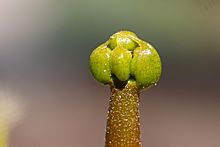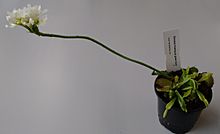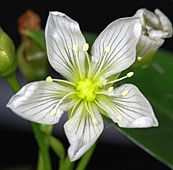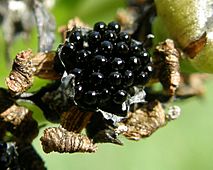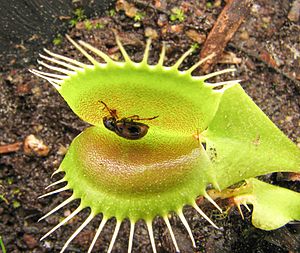Venus flytrap facts for kids
Quick facts for kids Venus flytrap |
|
|---|---|
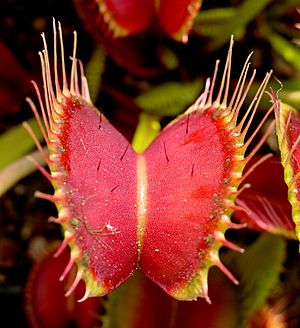 |
|
| Leaf | |
| Conservation status | |
| Scientific classification | |
| Genus: |
Dionaea
|
| Species: |
muscipula
|
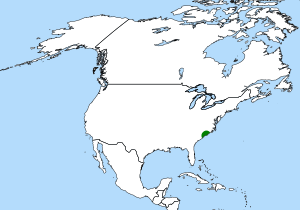 |
|
| Distribution | |
| Synonyms | |
|
|
The Venus flytrap (Dionaea muscipula) is a super cool carnivorous plant. It grows naturally in wetlands with a warm, wet climate, mostly along the East Coast of the United States. You can find it in North Carolina and South Carolina. This amazing plant catches its food, like insects and arachnids (spiders!), using a special trap. This trap is actually part of its leaves and snaps shut when tiny hairs inside are touched.
Even though many people grow Venus flytraps to sell, the number of these plants in the wild is shrinking fast. The U.S. Fish & Wildlife Service is currently looking into protecting them under the Endangered Species Act of 1973.
Contents
Where Do Venus Flytraps Live?
Venus flytraps are native to a very special place: a small area in the southeastern United States. This is mainly in North Carolina and South Carolina. They love places that are wet and have soil that doesn't have many nutrients. Think of bogs, swamps, and savannas. They also like sunny spots, but not too much direct sunlight that would scorch them.
What Does a Venus Flytrap Look Like?
The Venus flytrap is a small plant. It usually has four to seven leaves that grow in a circle, like a rosette. These leaves come from a short stem that looks like a bulb underground. Each stem can grow to be about three to ten centimeters long. The leaves with bigger traps usually grow after the plant has flowered. If you see a flytrap with more than seven leaves, it's probably a group of plants that have grown together underground.
The plant also grows a flower on a long stem, which can be about 15 centimeters (6 inches) tall. Different flying insects, like sweat bees, longhorn beetles, and checkered beetles, help pollinate the flower.
How the Trap Works
The most amazing part of the Venus flytrap is its trap! These traps are actually special leaves. They have two parts that are hinged, like a book, and can snap shut. Each part of the trap has three to five tiny, hair-like bristles on its inside surface. These bristles are super sensitive!
- The Trigger Mechanism: When an insect or other small creature lands on the trap and touches these trigger bristles, the plant reacts. It's smart, though! The trap usually needs two touches within a short time, or one strong touch that really bends a bristle. This clever trick stops the trap from closing for no reason, like from raindrops or small bits of debris.
- The Snap: Once it's triggered, the two parts of the trap snap shut incredibly fast. It takes only about one-tenth of a second! This is super quick for a plant, and it's really cool to watch. The edges of the trap have teeth-like spines that interlock, making it hard for the prey to escape.
- Digestion: After the trap closes, the plant starts to digest its meal. Special glands inside the trap release enzymes. These enzymes break down the soft parts of the captured creature. This releases nutrients that the plant can absorb. This whole process can take several days or even weeks, depending on how big the prey is. Once the nutrients are absorbed, the trap reopens, ready for its next meal!
What Do Venus Flytraps Eat?
The Venus flytrap's diet is mostly:
- 33% ants
- 30% spiders
- 10% beetles
- 10% grasshoppers
- Fewer than 5% are flying insects.
How Many Insects Do They Need?
A single Venus flytrap doesn't need to eat a lot of insects to stay alive. It might only catch and digest a few insects each year. But those few insects are super important for the flytrap. They give it the nutrients it can't get from the poor soil where it lives. It's a perfect example of how plants have adapted to survive in nature.
History and Discovery

People who lived in the area long ago, like indigenous people, probably knew about Venus flytraps for centuries. But it wasn't until the 1700s that these amazing plants became known to scientists around the world.
- Early Accounts: In 1768, Arthur Dobbs, who was the governor of North Carolina at the time, wrote a letter describing the plant and its fascinating trapping skills. This letter, and other early stories, helped introduce this incredible plant to the rest of the world.
- First Cultivation: Soon after scientists learned about them, Venus flytraps started to be grown in gardens. They made their way to other parts of the world because people were so amazed by their unusual features!
- Growing Knowledge: In the 1800s and beyond, scientists studied the plant more and more. This helped us understand how it works, where it lives, and how it traps insects. Today, research continues on many parts of the plant's life and how it interacts with its environment.
Why Are Venus Flytraps Important?
Beyond their incredible ability to trap insects, Venus flytraps are important for their ecosystems. They are a fascinating example of how plants have adapted to live in tough environments. They also add to the amazing variety of life, called biodiversity, in the special places where they grow. Studying them helps us understand the wonders of nature and all the different kinds of plants on our planet.
A substance from the Venus flytrap is sometimes used as a herbal remedy.
Protecting Venus Flytraps
Because they are so popular, Venus flytraps in the wild face many dangers. These include agriculture (farming), building roads, and people taking them illegally (poaching). Other threats are drainage of wetlands, stopping natural fires, and pollution from things like fertilizer.
Losing their natural homes, called habitat loss, is a big problem for these plants.
Poaching has also caused their numbers to drop. It became illegal to collect Venus flytraps from public land in North Carolina in 1958. Since then, a legal industry has grown, raising thousands of flytraps in special greenhouses to sell as house plants.
Also, Venus flytraps are very sensitive to big natural disasters. Most places where they grow are only 2–4 meters (6.5 –13 feet) above sea level. This area often gets hurricanes, so storm surges and rising sea levels are a long-term threat.
Cool Facts About Venus Flytraps
- The plant's common name, "Venus flytrap," comes from Venus, the Roman goddess of love.
- They can live for up to 20 years!
- A big study in 2019 counted about 302,000 Venus flytraps still living in the wild where they are native.
- In 2005, the Venus flytrap was named the official state carnivorous plant of North Carolina.
Images for kids
-
Drosera falconeri, a different type of carnivorous plant with sticky leaf traps
See also
 In Spanish: Dionaea muscipula para niños
In Spanish: Dionaea muscipula para niños





